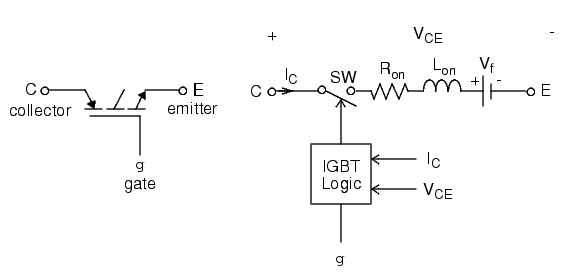

| SimPowerSystems |   |
Implement an insulated gate bipolar transistor (IGBT)
Library
Description
The IGBT block implements a semiconductor device controllable by the gate signal. The IGBT is simulated as a series combination of a resistor Ron, inductor Lon, and a DC voltage source Vf in series with a switch controlled by a logical signal (g > 0 or g = 0).

The IGBT turns on when the collector-emitter voltage is positive and greater than Vf and a positive signal is applied at the gate input (g > 0). It turns off when the collector-emitter voltage is positive and a 0 signal is applied at the gate input (g = 0).
The IGBT device is in the off state when the collector-emitter voltage is negative. Note that many commercial IGBTs do not have the reverse blocking capability. Therefore, they are usually used with an antiparallel diode.
The IGBT block contains a series Rs-Cs snubber circuit, which is connected in parallel with the IGBT device (between nodes C and E).
The turnoff characteristic of the IGBT model is approximated by two segments. When the gate signal falls to 0, the collector current decreases from Imax to 0.1 Imax during the fall time (Tf), and then from 0.1 Imax to 0 during the tail time (Tt).
Dialog Box and Parameters
 ).
). 0.  ). Set the Snubber resistance Rs parameter to
). Set the Snubber resistance Rs parameter to inf to eliminate the snubber from the model. 0 to eliminate the snubber, or to inf to get a resistive snubber.Inputs and Outputs
The input port (g) is a logical Simulink signal applied to the gate. The output port is a measurement vector [Ic Vce] returning the IGBT current and voltage.
Assumptions and Limitations
The IGBT block implements a macromodel of the real IGBT device. It does not take into account either the geometry of the device or the complex physical processes [1].
The IGBT block is modeled as a current source. It cannot be connected in series with an inductor, a current source, or an open circuit, unless its snubber circuit is in use. In order to avoid an algebraic loop, you cannot set the IGBT block inductance Lon to 0. Each IGBT block adds an extra state to the electrical circuit model. See Advanced Topics, for more details on this topic.
Circuits containing individual IGBT blocks cannot be discretized. However, discretization is permitted for IGBT/Diode bridges simulated with the Universal Bridge block.
You must use a stiff integrator algorithm to simulate circuits containing IGBTs. ode23tb or ode15s with default parameters usually gives the best simulation speed.
Example
The psbigbtconv.mdl demo illustrates the use of the IGBT block in a boost DC-DC converter. The IGBT is switched on and off at a frequency of 10 kHz to transfer energy from the DC source to the load (RC). The average output voltage (VR) is a function of the duty cycle ( ) of the IGBT switch:
) of the IGBT switch:
Run the simulation and observe the inductor current (IL), the IGBT collector current (IC), the diode current (ID), the IGBT device collector-emitter voltage (VCE), and the load voltage (VR).
References
[1] Mohan, N., T.M. Undeland, and W.P. Robbins, Power Electronics: Converters, Applications, and Design, John Wiley & Sons, Inc., New York, 1995.
See Also
GTO, MOSFET, Thyristor, Universal Bridge
 | Ideal Switch | Impedance Measurement |  |